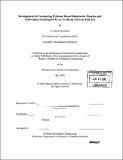| dc.contributor.advisor | Ian Hunter. | en_US |
| dc.contributor.author | Davidson, S. Naomi (Sarah Naomi) | en_US |
| dc.contributor.other | Massachusetts Institute of Technology. Dept. of Mechanical Engineering. | en_US |
| dc.date.accessioned | 2006-03-29T18:37:39Z | |
| dc.date.available | 2006-03-29T18:37:39Z | |
| dc.date.copyright | 2005 | en_US |
| dc.date.issued | 2005 | en_US |
| dc.identifier.uri | http://hdl.handle.net/1721.1/32362 | |
| dc.description | Thesis (S.M.)--Massachusetts Institute of Technology, Dept. of Mechanical Engineering, 2005. | en_US |
| dc.description | Includes bibliographical references. | en_US |
| dc.description.abstract | Fish possess a greater degree of agility, maneuverability, and energy efficiency over current underwater vehicles constructed by engineers. Kinematics studies show that a high degree of three-dimensional control of multiple active surfaces distributed around an undersea vehicle's center of mass is critical to achieve fish-like superior performance. However, current technology has yet to exploit the use of actively controlled surfaces for underwater locomotion. Major obstacles limiting effectively achieving designs capable of active deformations in multiple degrees of freedom lie in the complexity associated with traditional actuators and their associated manufacturing techniques. Conducting polymers possess numerous desirable physical and active properties which make it possible to grow rather than build artificial muscles for an articulated device. Their potential for co-fabrication make it possible to implement simpler more integrated designs as they have been shown to provide all the basic elements required for a Biomimetic robot including: force sensors (analogous to the Golgi organs in tendons), strain sensors (like muscle spindles), structural elements (such as bones, joints, and webbing), and actuators (akin to muscle). Rapid prototyping and molding techniques were used to begin the development of a co-fabrication process for a pectoral fin which will be made from and actuated by conducting polymers. Conducting polymer actuators provide the necessary structural flexibility while exceeding the 800 kN/m² force requirements typical of fish muscle by 40 fold. | en_US |
| dc.description.abstract | (cont.) Maximum speed requirements of 2.1 Hz for swimming speeds up to 1.1 TLs⁻¹ (total body length/s) are attainable at the strains required for metrics of the current artificial fin design. | en_US |
| dc.description.statementofresponsibility | by S. Naomi Davidson. | en_US |
| dc.format.extent | 136, [8] leaves | en_US |
| dc.format.extent | 9458789 bytes | |
| dc.format.extent | 9466686 bytes | |
| dc.format.mimetype | application/pdf | |
| dc.format.mimetype | application/pdf | |
| dc.language.iso | eng | en_US |
| dc.publisher | Massachusetts Institute of Technology | en_US |
| dc.rights | M.I.T. theses are protected by copyright. They may be viewed from this source for any purpose, but reproduction or distribution in any format is prohibited without written permission. See provided URL for inquiries about permission. | en_US |
| dc.rights.uri | http://dspace.mit.edu/handle/1721.1/7582 | |
| dc.subject | Mechanical Engineering. | en_US |
| dc.title | Development of conducting polymer based biomimetic muscles and fabrication techniques for an artificial pectoral fish fin | en_US |
| dc.type | Thesis | en_US |
| dc.description.degree | S.M. | en_US |
| dc.contributor.department | Massachusetts Institute of Technology. Department of Mechanical Engineering | |
| dc.identifier.oclc | 61494174 | en_US |
